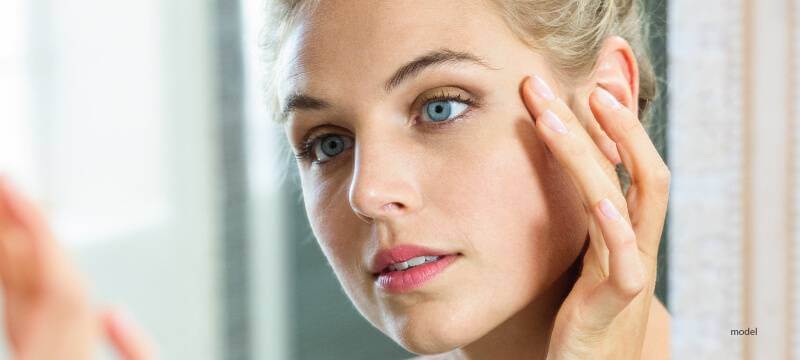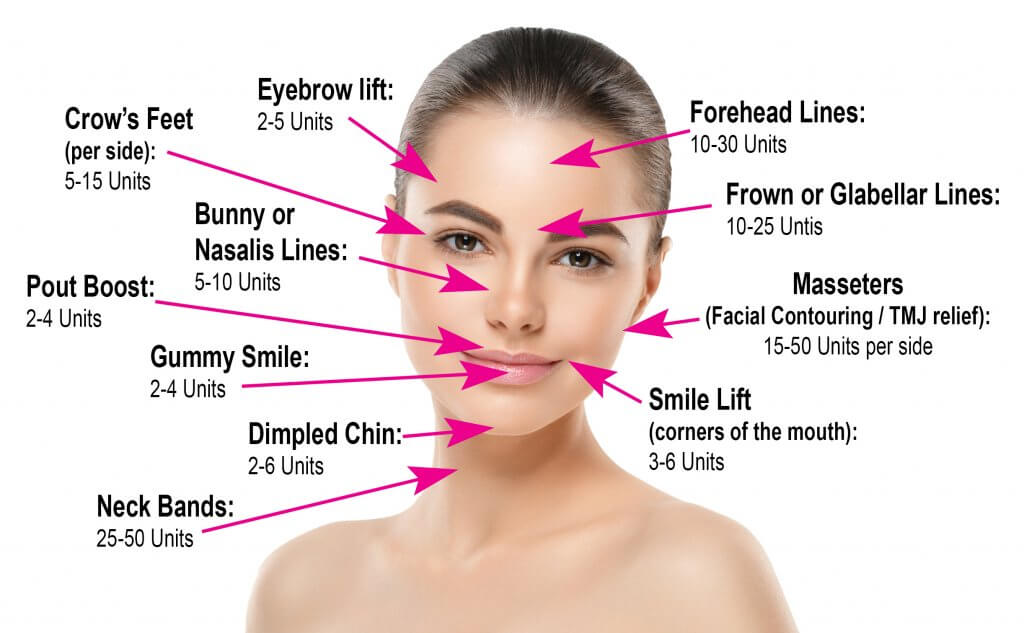Common Botox Injection Sites: What Facial Areas Can Be Treated With Botox

Botox is an anti-aging and skin smoothing solution. The safe injections work by temporarily causing muscle weakness at the injection site, which reduces the appearance of wrinkles and fine lines.
Botox is the most frequently performed non-surgical cosmetic procedure in the United States, but has other medical applications as well. Patients seek Botox treatments for migraine headaches, TMJ and more.
Botox Treatment Areas for Cosmetic Enhancement

Botox is injected using small needles to minimize pain. Your doctor may numb the injection site ahead of time with ice packs or topical numbing cream. You may be asked to make facial expressions like squinting, smiling or frowning to help your doctor locate the best site for injection.
Botox is typically priced per unit. Some areas require more units than others, and some also respond better to treatment than others. Depending on the area treated, Botox will last for 3-6 months.
Forehead (10-30 units)
The forehead is the most common Botox injection site, as it’s where many people first see the signs of aging. Horizontal wrinkles along the brow are easily treated with Botox injections.
Between Eyebrows (10-25 units)
The area between your eyebrows, also known as the glabella, or “11” lines, is also a popular treatment area. Smoothing out these vertical wrinkles corrects a tired or angry appearance for a more vibrant look.
Upper Eyebrow (2-5 units each side)
Botox injected into the upper eyebrow can mimic the effects of an eyebrow lift by relaxing the muscles that cause upper eyelids to droop.
Crow’s Feet (5-15 units each side)
Crow’s feet are the small, branching wrinkles that form at the corner of the eye when smiling. The skin in this area is much thinner than in other parts of the face, exacerbating the appearance of wrinkles.
Bunny Lines (5-10 unites each side)
Bunny lines, otherwise known as nasalis lines, are the rabbit-like wrinkles that appear on the side of your nose when you scrunch up your face, smile or laugh. These lines sometimes extend upwards to the lower eyelid.
Dimpled Chin (2-6 units)
A puckered or dimpled chin can worsen with age as the muscles in the chin area become more overactive. The natural age-related loss of collagen increases this dimpled appearance. Botox smooths the chin area for a more youthful look.
Smile Lines (3-6 units each side)
Lines that form at the corners of the mouth can sometimes extend downwards towards the jaw, or even cause the corners of the mouth to droop. Botox injections at this site can help you maintain a happier, more lively appearance.
Neck Bands (25-50 units)
Both horizontal and vertical wrinkles appear in the neck area with age. Botox works by preventing neck muscles from sagging, and can also improve the jawline for a look that mimics the results of a neck lift.
Non-Surgical Nose Job (2-4 units)
Botox applied to the base of the nose can raise the nasal tip. This works by weakening the muscles which pull the tip of the nose down as you smile or talk. Sometimes known as liquid rhinoplasty, this technique can be combined with dermal fillers for a re-contouring of the nose.
Botox Lip Flip (10 units)
Otherwise known as a Botox lip lift, this technique may also be done with Botox alone or combine with lip fillers. Botox provides a fuller lip pout by mildly rolling the upper lip outward. Fine lines around the upper lip are minimized as a pleasant side effect of this procedure.
Gummy Smile Treatment (2-4 units)
Excessive elevating of the upper lip when smiling is known as a gummy smile, as the gums above the front teeth become exposed. Injecting Botox can weaken the retractor muscles that cause this effect.
Alternative (Off Label) Uses for Botox
Known as off-label uses, most of these non-cosmetic applications actually have been FDA approved. Botox could be the solution to your acne, muscle spasms, depression or neck pain. We outline some of the most common off-label uses below.
Temporomandibular Joint Disfunction – TMJ (20-100 units)
Commonly known as TMJ, the temporomandibular joint connects your jawbone and scull. Chronic pain and disorders result from injury or trauma, inflammation, arthritis, or overuse due to aging or teeth grinding.
Botox can alleviate TMJ pain by reducing tension in the jaw, relaxing muscles for ease of movement, and relieving associated headaches. For TMJ pain, your doctor may inject Botox into your jaw, temple, or forehead.
Migraine (30-150 units)
Treating migraine and chronic headaches with Botox has been FDA approved since 2010. Depending upon the type and severity of your migraines, injections may include the bridge of your nose, temples, or forehead, and even your neck, the back of your head and the area above your shoulder blades.
Treatment works best as a series. Some patients respond best after at least 2 sessions. Results should be apparent within 1-2 weeks after the injection, and can last for upwards of three months. Botox treatment should not conflict with any oral medications you are currently taking for acute of chronic migraine.
Excessive Sweating (40-150 units)
Hyperhidrosis is a medical condition that causes excessive sweating even without the usual triggers of exercise, heat or stress. Those who suffer this condition may sweat up to five times more than the average person, making daily activity uncomfortable, embarrassing, and stressful.
Botox injected into the underarm can bring sweating back to normal levels, and is life changing for those with this disorder. Treatment areas can also include the forehead, upper lip, groin, or back.
Overactive Bladder (200 units)
Incontinence, or overactive bladder, increases with age. Up to 20 percent of the population may experience this issue in their lifetime. Because unintentional urine loss occurs when the bladder contracts, relaxing the muscles of the bladder reduces this embarrassing and stressful disorder.
After Botox treatments, patients have more time to find a bathroom after the onset of the need to urinate. Relief of symptoms can begin as early as 1-2 days after treatment.
Researchers continue to study off-label uses of Botox for future FDA approval of a variety of disorders and uncomfortable conditions.
Disclaimer: The contents of the Westlake Dermatology website, including text, graphics, and images, are for informational purposes only and are not intended to substitute for direct medical advice from your physician or other qualified professional.

Not something I’ve been looking for, but this is something important to know 😉
Typically, how much does it cost to have your whole face done?
Thanks for your question Tammy! A rough range would be between $400 and $1,000, but it really depends upon how much Botox you would need. Also, most patients will not need a full face treatment but rather a targeted approach is more beneficial. We would encourage you to come in for an in-person assessment to determine the best treatment plan (and true cost) to accomplish your goals.
Thanks again,
WD Staff